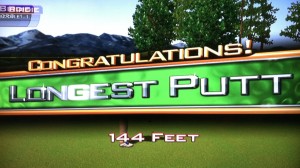This article stems from a comment by DesignMaster about the strength of the putter relative to distance from the hole. Here is his original post:
“I’ve been testing this theory this past week and have learned a few things, mostly that I can’t putt. LOL. I’m still trying to proof this, but I’m working on the hypothesis that there are different ranges for the putter. For example, the putter is preset for 20 feet, 40 feet, 60 feet and 100 feet. Thus, a 19 foot putt is going to break severely with a 20 foot putter, whereas a 21 foot putt barely breaks when you have the 40 foot putter. Also, you can’t reach a 20 foot putt with an up 10 degrees with a 20 foot putter. Unfortunately, you don’t get the choice of what strength your putter will be. I’ll update this when I have more accurate numbers, until then, let’s just say that this is an unproven tip.”
Since, there have been several replies. This was Dannyboy’s original reply:
“I’m 99% sure they do it based off of a percentage. Just guessing here, but I think it’s set at about 125%. (up to 120 ft though)
And the reason some putts come off different is a couple things.
1: The game will say 6′ and you putt it in and it says 4′. That is a nice not. So that would be why a putt didn’t feel right when you hit it, the game misread the distance, so it didn’t allow for enough hardness to hit it with.
B: Certain greens play different than the rest. You just need to remember which ones, because they are consistantly different. (quick example: meaning if hole 6 of Summit rolls over on a down 5 putt, it always will in the same situations while every other hole with a down 5 will never roll over)
One thing to remember if you are a thumb putter, a big left breaker is harder to hit because of the way the rollers are set underneath. And when you thumb it, the ball will tend to hop off the rollers at the beginning and not allow you to hit it where you are aiming.
Lots more practice needed for this type of putt.”
Kinzler rebutted with this comment:
“Sorry to tell you, this is 100% false. I have never seen an up 10 putt not get to the hole from anywhere inside 80 feet (although an up 11 or 12 may very well come up short. The only way it won’t get there is if you’re on the fringe (fringe putts may not go more than 7 yards).
Also a 19 foot putt and a 21 foot putt will break the same everytime. There are no different types of putters. The only reason the putt may break differently is the speed the golfer has hit his putt. Obviously the harder you hit a putt the less break you have to play. This is the same theory that you need to play more break on severe uphill putts because the ball is coming off the putter slower. In turn the opposite happens for downhill putts.”
FRO HOU added this point about break:
“Putts longer than 60-70 feet with break play differently than shorter putts. The ball shoots off the putter face and goes out wider than you expect. You have to play a 70 ft left 5 like a left 2.”
Finally, AMJ added this:
“I think there is a “20 foot putter” and a “40 foot putter”. That’s not to say that is how far those putters will go but once you get beyond those distances the putter will go to the next level of putt power.
That’s how I attributed the magic 60′ rollever distance. Once a putt got over 60′ is went to the “90 foot putter” and that’s why putts in the 60-75′ range might have rolled over.”
Make what you will of this conversation topic, but practice will teach you the best how putts act!
 Every now and then while playing Golden Tee Live, I’ll come across a situation on the green where the hole doesn’t exactly match up in a straight line with my putter. Consequently, if I don’t notice this and simply putt based on the slope of the green, I might miss a putt that otherwise would have been made. I don’t know if this feature was meant to be built into Golden Tee, but I do notice it sometimes.
Every now and then while playing Golden Tee Live, I’ll come across a situation on the green where the hole doesn’t exactly match up in a straight line with my putter. Consequently, if I don’t notice this and simply putt based on the slope of the green, I might miss a putt that otherwise would have been made. I don’t know if this feature was meant to be built into Golden Tee, but I do notice it sometimes.





